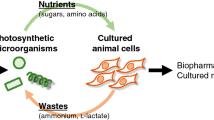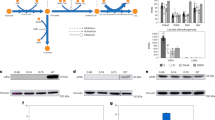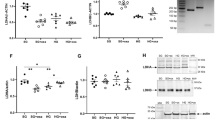Abstract
It is well established that lactate secreted by fermenting cells can be oxidized or used as a gluconeogenic substrate by other cells and tissues. It is generally assumed, however, that within the fermenting cell itself, lactate is produced to replenish NAD+ and then is secreted. Here we explore the possibility that cytosolic lactate is metabolized by the mitochondria of fermenting mammalian cells. We found that fermenting HeLa and H460 cells utilize exogenous lactate carbon to synthesize a large percentage of their lipids. Using high-resolution mass spectrometry, we found that both 13C and 2-2H labels from enriched lactate enter the mitochondria. The lactate dehydrogenase (LDH) inhibitor oxamate decreased respiration of isolated mitochondria incubated in lactate, but not of isolated mitochondria incubated in pyruvate. Additionally, transmission electron microscopy (TEM) showed that LDHB localizes to the mitochondria. Taken together, our results demonstrate a link between lactate metabolism and the mitochondria of fermenting mammalian cells.
This is a preview of subscription content, access via your institution
Access options
Subscribe to this journal
Receive 12 print issues and online access
$259.00 per year
only $21.58 per issue
Buy this article
- Purchase on SpringerLink
- Instant access to full article PDF
Prices may be subject to local taxes which are calculated during checkout





Similar content being viewed by others

References
Lehninger, A., Nelson, D. & Cox, M.E. Lehninger Principles of Biochemistry (W.H. Freeman and Company, 2008).
Cori, C.F. & Cori, G.T. Carbohydrate metabolism. Annu. Rev. Biochem. 15, 193–218 (1946).
Nielsen, H.B., Clemmesen, J.O., Skak, C., Ott, P. & Secher, N.H. Attenuated hepatosplanchnic uptake of lactate during intense exercise in humans. J. Appl. Physiol. 92, 1677–1683 (2002).
Bonvento, G., Herard, A.-S. & Voutsinos-Porche, B. The astrocyte–neuron lactate shuttle: a debated but still valuable hypothesis for brain imaging. J. Cereb. Blood Flow Metab. 25, 1394–1399 (2005).
Pavlides, S. et al. The reverse Warburg effect: aerobic glycolysis in cancer associated fibroblasts and the tumor stroma. Cell Cycle 8, 3984–4001 (2009).
Kane, D.A. Lactate oxidation at the mitochondria: a lactate-malate-aspartate shuttle at work. Front. Neurosci. 8, 366 (2014).
Hashimoto, T., Hussien, R. & Brooks, G.A. Colocalization of MCT1, CD147, and LDH in mitochondrial inner membrane of L6 muscle cells: evidence of a mitochondrial lactate oxidation complex. Am. J. Physiol. Endocrinol. Metab. 290, E1237–E1244 (2006).
Brooks, G.A., Dubouchaud, H., Brown, M., Sicurello, J.P. & Butz, C.E. Role of mitochondrial lactate dehydrogenase and lactate oxidation in the intracellular lactate shuttle. Proc. Natl. Acad. Sci. USA 96, 1129–1134 (1999).
Chen, Y.-J. et al. Differential incorporation of glucose into biomass during Warburg metabolism. Biochemistry 53, 4755–4757 (2014).
Brandt, R.B., Laux, J.E., Spainhour, S.E. & Kline, E.S. Lactate dehydrogenase in rat mitochondria. Arch. Biochem. Biophys. 259, 412–422 (1987).
Markert, C.L., Shaklee, J.B. & Whitt, G.S. Evolution of a gene. Multiple genes for LDH isozymes provide a model of the evolution of gene structure, function and regulation. Science. 189, 102–114 (1975).
Takasu, T. & Hughes, B.P. Lactate dehydrogenase isozyme patterns in human skeletal muscle. I. Variation of isozyme pattern in the adult. J. Neurol. Neurosurg. Psychiatry 32, 175–179 (1969).
Sjödin, B. Lactate dehydrogenase in human skeletal muscle. Acta Physiol. Scand. Suppl. 436, 1–32 (1976).
Shaw, C.R. & Barto, E. Genetic evidence for the subunit structure of lactate dehydrogenase isozymes. Proc. Natl. Acad. Sci. USA 50, 211–214 (1963).
Dawson, D.M., Goodfriend, T.L. & Kaplan, N.O. Lactic dehydrogenases: functions of the two types. Science 143, 929–933 (1964).
Doherty, J.R. & Cleveland, J.L. Targeting lactate metabolism for cancer therapeutics. J. Clin. Invest. 123, 3685–3692 (2013).
Elustondo, P.A. et al. Physical and functional association of lactate dehydrogenase (LDH) with skeletal muscle mitochondria. J. Biol. Chem. 288, 25309–25317 (2013).
Brooks, G.A. Intra- and extra-cellular lactate shuttles. Med. Sci. Sports Exerc. 32, 790–799 (2000).
van Hall, G. et al. Blood lactate is an important energy source for the human brain. J. Cereb. Blood Flow Metab. 29, 1121–1129 (2009).
Gladden, L.B. Lactate metabolism: a new paradigm for the third millennium. J. Physiol. (Lond.) 558, 5–30 (2004).
Kennedy, B.W.C., Kettunen, M.I., Hu, D.-E. & Brindle, K.M. Probing lactate dehydrogenase activity in tumors by measuring hydrogen/deuterium exchange in hyperpolarized l-[1-(13)C,U-(2)H]lactate. J. Am. Chem. Soc. 134, 4969–4977 (2012).
Greenhouse, W.V. & Lehninger, A.L. Magnitude of malate-aspartate reduced nicotinamide adenine dinucleotide shuttle activity in intact respiring tumor cells. Cancer Res. 37, 4173–4181 (1977).
Chiaretti, B., Casciaro, A., Minotti, G., Eboli, M.L. & Galeotti, T. Quantitative evaluation of the activity of the malate-aspartate shuttle in Ehrlich ascites tumor cells. Cancer Res. 39, 2195–2199 (1979).
Bücher, T. & Klingenberg, M. Wege des Wasserstoffs in der lebendigen Organisation. Angew. Chem. 70, 552–570 (1958).
O'Donnell, J.M., Kudej, R.K., LaNoue, K.F., Vatner, S.F. & Lewandowski, E.D. Limited transfer of cytosolic NADH into mitochondria at high cardiac workload. Am. J. Physiol. Heart Circ. Physiol. 286, H2237–H2242 (2004).
Hashimoto, T., Hussien, R., Cho, H.-S., Kaufer, D. & Brooks, G.A. Evidence for the mitochondrial lactate oxidation complex in rat neurons: demonstration of an essential component of brain lactate shuttles. PLoS ONE 3, e2915 (2008).
Ivanisevic, J. et al. Toward 'omic scale metabolite profiling: a dual separation-mass spectrometry approach for coverage of lipid and central carbon metabolism. Anal. Chem. 85, 6876–6884 (2013).
Frezza, C., Cipolat, S. & Scorrano, L. Organelle isolation: functional mitochondria from mouse liver, muscle and cultured fibroblasts. Nat. Protoc. 2, 287–295 (2007).
Schugar, R.C., Huang, X., Moll, A.R., Brunt, E.M. & Crawford, P.A. Role of choline deficiency in the Fatty liver phenotype of mice fed a low protein, very low carbohydrate ketogenic diet. PLoS ONE 8, e74806 (2013).
Lanza, I.R. & Nair, K.S. Functional assessment of isolated mitochondria in vitro. Methods Enzymol. 457, 349–372 (2009).
Kuznetsov, A.V. et al. Analysis of mitochondrial function in situ in permeabilized muscle fibers, tissues and cells. Nat. Protoc. 3, 965–976 (2008).
Rogers, G.W. et al. High throughput microplate respiratory measurements using minimal quantities of isolated mitochondria. PLoS ONE 6, e21746 (2011).
Stueber, D., Mehta, A.K., Chen, Z., Wooley, K.L. & Schaefer, J. Local order in polycarbonate glasses by 13C{19F} rotational-echo double-resonance NMR. J. Polym. Sci. B Polym. Phys. 44, 2760–2775 (2006).
Chambers, M.C. et al. A cross-platform toolkit for mass spectrometry and proteomics. Nat. Biotechnol. 30, 918–920 (2012).
Mahieu, N.G., Spalding, J.L. & Patti, G.J. Warpgroup: increased precision of metabolomic data processing by consensus integration bound analysis. Bioinformatics 32, 268–275 (2016).
Huang, X. et al. X13CMS: global tracking of isotopic labels in untargeted metabolomics. Anal. Chem. 86, 1632–1639 (2014).
Acknowledgements
This work was supported by funding from the National Institutes of Health grants R01 ES022181 (G.J.P.), R21 CA191097-01A1 (G.J.P.), R01 HL118639-03 (R.W.G.), R01 DK091538 (P.A.C.), and R01 EB002058 (J.S.), as well as grants from the Alfred P. Sloan Foundation (G.J.P.), the Camille & Henry Dreyfus Foundation (G.J.P.), and the Pew Scholars Program in the Biomedical Sciences (G.J.P.). We thank W. Beatty at Washington University's Molecular Microbiology Imaging Facility for acquiring the TEM images.
Author information
Authors and Affiliations
Contributions
Y.-J.C. prepared samples, carried out biochemical assays, and performed LC/MS analyses. Y.-J.C., M.S., and J.S. performed NMR analyses. Y.-J.C., N.G.M., X.H., M.S., P.A.C., S.L.J., R.W.G., J.S., and G.J.P. contributed to experimental design and data interpretation. Y.-J.C., N.G.M., and G.J.P. wrote the manuscript.
Corresponding author
Ethics declarations
Competing interests
G.J.P. is a scientific advisory board member for Cambridge Isotope Laboratories, Tewksbury, Massachusetts, USA. R.W.G. has financial relationships with LipoSpectrum and Platomics. P.A.C. serves as a consultant and on a scientific advisory board for Janssen Pharmaceuticals, Titusville, New Jersey, USA.
Supplementary information
Supplementary Text and Figures
Supplementary Results, Supplementary Figures 1–12 and Supplementary Tables 1–3. (PDF 13674 kb)
Rights and permissions
About this article
Cite this article
Chen, YJ., Mahieu, N., Huang, X. et al. Lactate metabolism is associated with mammalian mitochondria. Nat Chem Biol 12, 937–943 (2016). https://doi.org/10.1038/nchembio.2172
Received:
Accepted:
Published:
Issue date:
DOI: https://doi.org/10.1038/nchembio.2172
This article is cited by
-
Nanoscale metal–organic frameworks as smart nanocarriers for cancer therapy
Journal of Nanostructure in Chemistry (2024)
-
Cytosolic and mitochondrial NADPH fluxes are independently regulated
Nature Chemical Biology (2023)
-
Metabolic pathway analysis using stable isotopes in patients with cancer
Nature Reviews Cancer (2023)
-
Combining PEGylated mito-atovaquone with MCT and Krebs cycle redox inhibitors as a potential strategy to abrogate tumor cell proliferation
Scientific Reports (2022)
-
Effects of Fibroblast Growth Factor 21 on Lactate Uptake and Usage in Mice with Diabetes-Associated Cognitive Decline
Molecular Neurobiology (2022)


